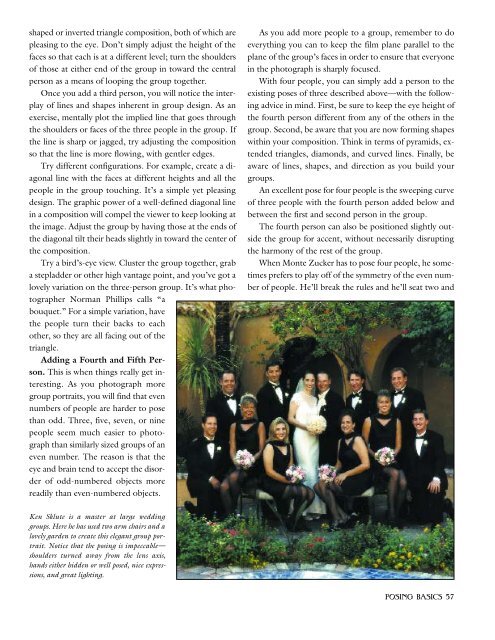The Best of Wedding Photography.pdf - Free
The Best of Wedding Photography.pdf - Free
The Best of Wedding Photography.pdf - Free
Create successful ePaper yourself
Turn your PDF publications into a flip-book with our unique Google optimized e-Paper software.
shaped or inverted triangle composition, both <strong>of</strong> which are<br />
pleasing to the eye. Don’t simply adjust the height <strong>of</strong> the<br />
faces so that each is at a different level; turn the shoulders<br />
<strong>of</strong> those at either end <strong>of</strong> the group in toward the central<br />
person as a means <strong>of</strong> looping the group together.<br />
Once you add a third person, you will notice the interplay<br />
<strong>of</strong> lines and shapes inherent in group design. As an<br />
exercise, mentally plot the implied line that goes through<br />
the shoulders or faces <strong>of</strong> the three people in the group. If<br />
the line is sharp or jagged, try adjusting the composition<br />
so that the line is more flowing, with gentler edges.<br />
Try different configurations. For example, create a diagonal<br />
line with the faces at different heights and all the<br />
people in the group touching. It’s a simple yet pleasing<br />
design. <strong>The</strong> graphic power <strong>of</strong> a well-defined diagonal line<br />
in a composition will compel the viewer to keep looking at<br />
the image. Adjust the group by having those at the ends <strong>of</strong><br />
the diagonal tilt their heads slightly in toward the center <strong>of</strong><br />
the composition.<br />
Try a bird’s-eye view. Cluster the group together, grab<br />
a stepladder or other high vantage point, and you’ve got a<br />
lovely variation on the three-person group. It’s what photographer<br />
Norman Phillips calls “a<br />
bouquet.” For a simple variation, have<br />
the people turn their backs to each<br />
other, so they are all facing out <strong>of</strong> the<br />
triangle.<br />
Adding a Fourth and Fifth Person.<br />
This is when things really get interesting.<br />
As you photograph more<br />
group portraits, you will find that even<br />
numbers <strong>of</strong> people are harder to pose<br />
than odd. Three, five, seven, or nine<br />
people seem much easier to photograph<br />
than similarly sized groups <strong>of</strong> an<br />
even number. <strong>The</strong> reason is that the<br />
eye and brain tend to accept the disorder<br />
<strong>of</strong> odd-numbered objects more<br />
readily than even-numbered objects.<br />
Ken Sklute is a master at large wedding<br />
groups. Here he has used two arm chairs and a<br />
lovely garden to create this elegant group portrait.<br />
Notice that the posing is impeccable—<br />
shoulders turned away from the lens axis,<br />
hands either hidden or well posed, nice expressions,<br />
and great lighting.<br />
As you add more people to a group, remember to do<br />
everything you can to keep the film plane parallel to the<br />
plane <strong>of</strong> the group’s faces in order to ensure that everyone<br />
in the photograph is sharply focused.<br />
With four people, you can simply add a person to the<br />
existing poses <strong>of</strong> three described above—with the following<br />
advice in mind. First, be sure to keep the eye height <strong>of</strong><br />
the fourth person different from any <strong>of</strong> the others in the<br />
group. Second, be aware that you are now forming shapes<br />
within your composition. Think in terms <strong>of</strong> pyramids, extended<br />
triangles, diamonds, and curved lines. Finally, be<br />
aware <strong>of</strong> lines, shapes, and direction as you build your<br />
groups.<br />
An excellent pose for four people is the sweeping curve<br />
<strong>of</strong> three people with the fourth person added below and<br />
between the first and second person in the group.<br />
<strong>The</strong> fourth person can also be positioned slightly outside<br />
the group for accent, without necessarily disrupting<br />
the harmony <strong>of</strong> the rest <strong>of</strong> the group.<br />
When Monte Zucker has to pose four people, he sometimes<br />
prefers to play <strong>of</strong>f <strong>of</strong> the symmetry <strong>of</strong> the even number<br />
<strong>of</strong> people. He’ll break the rules and he’ll seat two and<br />
POSING BASICS 57

















